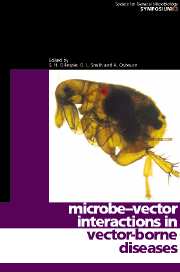Book contents
- Frontmatter
- Contents
- Contributors
- Editors' Preface
- 1 Vector-borne diseases
- 2 Evolution of tick-borne disease systems
- 3 Insect transmission of viruses
- 4 RNA-based immunity in insects
- 5 Specificity of Borrelia–tick vector relationships
- 6 Bunyavirus/mosquito interactions
- 7 How do mosquito vectors live with their viruses?
- 9 Vector competence
- 9 Environmental influences on arbovirus infections and vectors
- 10 Vector immunity
- 11 Transmission of plant viruses by nematodes
- 12 Wolbachia host–symbiont interactions
- 13 Pathogenic strategies of Anaplasma phagocytophilum, a unique bacterium that colonizes neutrophils
- 14 Interactions of Yersinia pestis with its flea vector that lead to the transmission of plague
- 15 Transgenic malaria
- 16 Vaccines targeting vectors
- Index
15 - Transgenic malaria
Published online by Cambridge University Press: 06 July 2010
- Frontmatter
- Contents
- Contributors
- Editors' Preface
- 1 Vector-borne diseases
- 2 Evolution of tick-borne disease systems
- 3 Insect transmission of viruses
- 4 RNA-based immunity in insects
- 5 Specificity of Borrelia–tick vector relationships
- 6 Bunyavirus/mosquito interactions
- 7 How do mosquito vectors live with their viruses?
- 9 Vector competence
- 9 Environmental influences on arbovirus infections and vectors
- 10 Vector immunity
- 11 Transmission of plant viruses by nematodes
- 12 Wolbachia host–symbiont interactions
- 13 Pathogenic strategies of Anaplasma phagocytophilum, a unique bacterium that colonizes neutrophils
- 14 Interactions of Yersinia pestis with its flea vector that lead to the transmission of plague
- 15 Transgenic malaria
- 16 Vaccines targeting vectors
- Index
Summary
INTRODUCTION
The life cycle of the causative agent of human malaria, the protozoan Plasmodium, involves transmission through both humans and the mosquito vector. Malaria can therefore be tackled on three distinct biological fronts. The most explored is the development of vaccines or drugs that kill the parasite during its passage through the human host. Drugs such as chloroquine have been used with considerable success; however, the emergence of resistance to these drugs has compromised their effectiveness in many regions of the world. Considerable efforts have been directed towards the development of vaccines for malaria; however, the ability of the parasite to evade the human acquired immune response has so far frustrated these attempts. The publication of the complete genomic sequence of Plasmodium falciparum (Gardner et al., 2002), the major malaria pathogen in sub-Saharan Africa, has rejuvenated efforts to develop drugs that will specifically target the parasite while minimizing side effects on the human host.
Development of malaria control or eradication strategies based on mosquito vector control has traditionally involved the use of chemical insecticides with or without elimination or reduction of excess standing water. These have been successful in terms of reducing or eliminating malaria from specific geographical regions. Regions of Europe, Asia, the Americas and Australia have been rendered malaria-free as a consequence of these area-wide strategies. The effectiveness of this approach has, however, diminished with the cessation of the application of DDT, the rapid emergence of resistance to insecticides amongst mosquito populations, and the overall reluctance of communities to accept the spraying of any chemical insecticide.
- Type
- Chapter
- Information
- Microbe-vector Interactions in Vector-borne Diseases , pp. 345 - 362Publisher: Cambridge University PressPrint publication year: 2004



